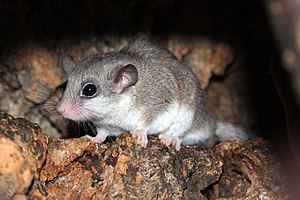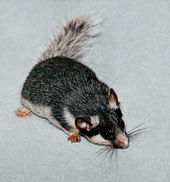African dormouse
| African dormouse | ||||||||||||
|---|---|---|---|---|---|---|---|---|---|---|---|---|

African dormouse ( Graphiurus (murinus?) ) |
||||||||||||
| Systematics | ||||||||||||
|
||||||||||||
| Scientific name of the subfamily | ||||||||||||
| Graphiurinae | ||||||||||||
| Winge , 1887 | ||||||||||||
| Scientific name of the genus | ||||||||||||
| Graphiurus | ||||||||||||
| Smuts , 1832 |
The African dormouse or brushtail bilche ( Graphiurus ) are tree-dwelling nocturnal animals of the African rainforests and savannas .
features
The species of the genus are consistently rather small with a head-trunk length of 7 to 16 centimeters, plus a 5 to 13 centimeter long tail. The largest species of the genus is Graphiurus nagtglasii . The typical color is gray on the top and white on the underside, with simple black and white facial markings, the goggle ( Graphiurus ocularis ) has a clearly more pronounced mask mark. The tail is gray with a white underside and a white tip of the tail. In their habitus, the African dormouse correspond to small tree-living squirrels , to which they are also similar in their way of life. Most species are very similar and therefore difficult to distinguish from one another, only a few species such as the eyeglasses have specific external characteristics.
The skull of the African dormouse is characterized by a short and often wide snout region as well as other very specific features. The zygomatic plate in front of the zygomatic arch is very narrow and lies completely below the infraorbital foramen . As with all squirrel-like muscles , the masticatory muscles and above all the masseter muscle and its attachment and guidance on the skull are basically hystricomorphic , but modified as is typical of the species. The incisors (incisors) form in plan view a typical V-shaped cutting surface and the molars ( Praemolares and Molar ) have only vague and incomplete in many species or missing enamel strips. Species that usually live in rock caves, such as the goggle or the African rock gill ( Graphiurus platyops ) differ from tree species in that they have a flattened cranium.
distribution
The distribution of the genus is restricted to sub- Saharan Africa ( sub-Saharan Africa ). Many species are only known from very limited distribution areas and are endemic in individual regions , while other species have larger distribution areas.
Way of life
African dormouse live in diverse habitats and are particularly widespread in tropical rainforest areas , wet and dry mountain forests, wooded savannahs and grasslands as well as in southern Africa in the Karoo and fynbos . In arid areas with no vegetation such as the Namib , the species are absent or only occur in the area of oases . Central elements of their habitats are trees, wooden tendrils, bushes and also Kopjes , in which the animals can hide and build their nests.
The animals are largely nocturnal and consistently good climbers. In forest areas they stay almost exclusively in the branches and the species that live in grasslands or rocky areas and are often found on the ground also look for bushes and trees. As omnivores, they mainly look for fruits, nuts, seeds and insects. The goggle, on the other hand, is largely insectivorous and accordingly feeds on insects. Some species, such as the Lorrain bilch ( Graphiurus lorraineus ) and the African forest bilch ( Graphiurus murinus ) survive periods of low temperatures or lack of food due to a sleep state, the torpor .
In the past, some of these dorms penetrated human dwellings and lived there in warehouses and attics. Today they have largely disappeared from human settlements due to competition from the introduced brown rat .
Evolution and systematics
evolution
The African dormouse are considered to be comparatively primitive rodents and squirrel-like species. It is believed that they have lived in Africa since the Miocene . The oldest fossils assigned to the Graphiurinae come from the late Miocene from Namibia and South Africa . The oldest representative is Otaviglis from Namibia, whose remains are around 10 to 11 million years old. It is believed that it may have evolved from Microdryomys in North Africa and is a direct ancestor of the genus Graphiurus . Phylogenetic studies and an estimate of the age of the genus based on the molecular clock suggest that the genus spread and adaptive radiation occurred about 8 to 10 million years ago.
Systematics
|
The African Bilche were from the South African Zoologist John Smuts 1832 as separate genus with the Brillenbilch ( Graphiurus ocularis ) as a type species described . Herluf Winge assigned them in 1887 to their own subfamily Graphiurinae within the dormouse, which is compared to the Glirinae and Leithiinae . The genus and subfamily was confirmed as a monophyletic group in molecular biological studies , it represents the most original taxon within the dormice and is compared to the common taxon from Glirinae and Leithiinae as a sister group .
The number of species as well as the assignment of subspecies varies in different publications, currently the following 15 species are included in this genus:

- Angola dormouse ( Graphiurus angolensis )
- Christys Bilch ( Graphiurus christyi )
- Jentink's Dormouse ( Graphiurus crassicaudatus )
- Johnston Dormouse ( Graphiurus johnstoni )
- Kellens Bilch ( Graphiurus kelleni )
- Lorrain's dormouse ( Graphiurus lorraineus )
- Small-eared bilch ( Graphiurus microtis )
- Monard's bilch ( Graphiurus monardi )
- African forest bilch ( Graphiurus murinus )
- Huet Bilch ( Graphiurus nagtglasii )
- Spectacle image ( Graphiurus ocularis )
- African rock bilch ( Graphiurus platyops )
- African stone bilch ( Graphiurus rupicola )
- African ornamental bilch ( Graphiurus surdus )
- Graphiurus walterverheyeni
supporting documents
- ↑ a b c d e f Mary Ellen Holden: Genus Graphiurus - African Dormice. In: Jonathan Kingdon, David Happold, Michael Hoffmann, Thomas Butynski, Meredith Happold and Jan Kalina (eds.): Mammals of Africa Volume III. Rodents, Hares and Rabbits. Bloomsbury, London 2013, pp. 109-110; ISBN 978-1-4081-2253-2
- ^ A b Claudine Montgelard, Conrad A. Matthee, Terence J. Robinson: Molecular systematics of dormice (Rodentia: Gliridae) and the radiation of Graphiurus in Africa. Proceedings of the Royal Society B: Biological Sciences 270, 2003; Pp. 1947-1955. doi : 10.1098 / rspb.2003.2458 .
- ↑ a b Graphiurus ( page no longer available , search in web archives ) Info: The link was automatically marked as defective. Please check the link according to the instructions and then remove this notice. . In: Don E. Wilson , DeeAnn M. Reeder (Eds.): Mammal Species of the World. A taxonomic and geographic Reference. 2 volumes. 3. Edition. Johns Hopkins University Press, Baltimore MD 2005, ISBN 0-8018-8221-4 .
- ^ List of species according to Mary Ellen Holden: Genus Graphiurus - African Dormice. In: Jonathan Kingdon, David Happold, Michael Hoffmann, Thomas Butynski, Meredith Happold and Jan Kalina (eds.): Mammals of Africa Volume III. Rodents, Hares and Rabbits. Bloomsbury, London 2013, pp. 109-134; ISBN 978-1-4081-2253-2
- ^ Mary Ellen Holden-Musser, R. Juškaitis, GM Musser: Genus Graphiurus. In: Don E. Wilson, TE Lacher, Jr., Russell A. Mittermeier (Eds.): Handbook of the Mammals of the World: Lagomorphs and Rodents 1. (HMW, Volume 6) Lynx Edicions, Barcelona 2016, p. 867 -877, ISBN 978-84-941892-3-4 .
literature
- Mary Ellen Holden-Musser, R. Juškaitis, GM Musser: Genus Graphiurus. In: Don E. Wilson, TE Lacher, Jr., Russell A. Mittermeier (Eds.): Handbook of the Mammals of the World: Lagomorphs and Rodents 1. (HMW, Volume 6) Lynx Edicions, Barcelona 2016, p. 867 -877, ISBN 978-84-941892-3-4 .
- Ronald M. Nowak: Walker's Mammals of the World. 2 volumes. 6th edition. Johns Hopkins University Press, Baltimore MD et al. 1999, ISBN 0-8018-5789-9 .
- Mary Ellen Holden: Genus Graphiurus - African Dormice. In: Jonathan Kingdon, David Happold, Michael Hoffmann, Thomas Butynski, Meredith Happold and Jan Kalina (eds.): Mammals of Africa Volume III. Rodents, Hares and Rabbits. Bloomsbury, London 2013, pp. 109-134; ISBN 978-1-4081-2253-2
